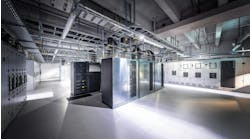In this edition of Voices of the Industry, Matt Vicker, Product Development Manager at Data Aire explores how data centers can choose an environmental control solution that best fits their ROI goals today and into the future.
Matt Vicker, Data Aire Product Development Manager
One thing is certain, optimal data center design is a complex puzzle to solve. With all the options available, no one environmental control system can fit all situations. You must consider all the solutions and technology available to best manage assets and adapt your evolving data center.
There is a precision cooling system for whatever scenario best fits your current strategy or future goals. The question only remains, have you considered each of the options with your design engineer and your environmental control manufacturer? The two need to be in synch to help you maximize your return on investment.
In most instances, if you want an environmental control system that scales with your needs, provides the lowest energy costs, and provides the most reliable airflow throughout your data center, a variable-speed system is your best solution. Nevertheless, you may be curious about what other options may suit your current application.
Precise Modulated Cooling | Greatest ROI and Highest Part-Load Efficiency
Companies need to decide on their strategy and design for it. When you know you have swings in your load – seasonal, day to day or even from one corner of the data center or electrical room to the other, you should consider variable speed technology. A system with variable speed technology and accurate control design modulates to precisely match the current cooling load. This precision gives the variable speed the highest efficiency at part-load, which equates to a greater return on investment. In other words, when your data center is not running at maximum cooling load a variable speed system will use less energy and save money.
If we think of the cooling output of your environmental control system as the accelerator of a car — you can press the pedal to almost infinite positions to exactly match the speed you want to travel. You are not wasting energy overshooting your desired speed. With a well-designed control system, you also ensure a smooth response to a change in load. Further efficiency is gained by accelerating at an efficient rate for the system.
Advanced Staged Cooling | Initial Costs and Great Part-Load Efficiency
If you are looking for something that offers a portion of the benefits of a variable speed system but at a reduced first-cost, a multi-stage cooling system can be a good compromise. A multi-stage system will manage some applications well and can reduce overcooling your space — as-built today. If you need greater turndown than what a fixed speed system offers, then this is a good choice for you.
If you find this to be the right-now solution for you, you’re in good hands. The system is more advanced than a fixed speed unit; it is developed with a level of design optimization to transition its small steps. Unlike digital scroll, this accurate solution, with two-stage compressors, has a high part-load efficiency.
Think about the car accelerator example again; there are many positions to move the accelerator to with a multi-speed system. With two-stage compressors the positions are precise and repeatable, meaning you can smartly change positions to prevent overshoot, and you are more likely to have a position that matches the speed that is desired.
Although the return on investment is better with a multi-stage than a fixed-speed system; the benefits are less than with a variable speed system.
Fixed-Speed Systems | Lowest Initial Cost and Lower Part-Load Efficiency
Some consider this the entry point for precision cooling based on their current budget constraints. So, if you are on a tight budget and need a lower first-cost, then a fixed-speed, single-stage precision cooling system may get the job done. However, this can be short-sighted as energy consumption and costs are higher when the data center is operating at less than the maximum designed cooling load. In our experience, this seems to happen quite frequently based on what the mechanical engineer has been asked to design vs. the actual heat load of the space.
If a fixed system is applied to the car accelerator example, you see how only applying 100% throttle or 0% throttle would prevent you from getting close to a precise speed. This is clearly not as efficient as the other examples unless you want to go at the car’s maximum speed all the time.
Ramping Up Your Data Center
The needs and goals of a data center can change over time. While the initial objective may only require getting the space in running order, customers may reassess based on changing scenarios. If your data center needs to scale, you may be challenged if you haven’t planned ahead with your design engineer for phased build-outs, or perhaps even varying IT load considerations that are seasonal or shift from day to day, or even hour to hour. Likewise, you may need to consider the difference between design and actual usage – whether it be too little or too much. Perhaps your IT team says they need two megawatts, or you are going to be running at 16 kw per rack. The cooling system designed may underserve your needs or may be overkill for the current state of usage. In addition, pushing your system to do more than it is engineered for can potentially accelerate the aging of your infrastructure.
Again, depending on your application, goals and business strategy, one of these three systems is right for you. The best course of action is to evaluate where you are today and then future-proof your data center with technology that can grow with you if necessary.
Matt Vicker is the product development manager at Data Aire. Contact them to learn more about how the right cooling system can boost your ROI.





